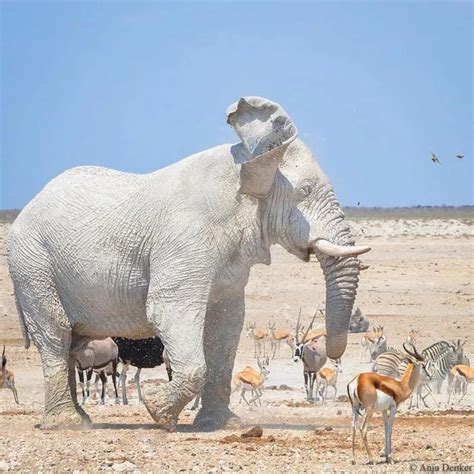
A rare albino elephant, nicknamed “Ghost,” has been sighted in Botswana for the first time in years, captivating wildlife enthusiasts and conservationists alike with its ethereal appearance. The pale-skinned calf, believed to be several years old, was photographed roaming with its herd in the African bush, a remarkable and unusual sight in the region.
The sighting, recently documented, offers a renewed sense of hope for the survival of these extraordinary creatures, who are particularly vulnerable due to their lack of protective pigmentation. Albino elephants are exceptionally rare, making “Ghost’s” reappearance a significant event for elephant conservation efforts.
“This is an incredibly rare sighting,” said a wildlife expert familiar with the area. “Albino elephants face numerous challenges, including increased sensitivity to the sun and potential eyesight issues, making their survival more difficult.”
Albino elephants, while genetically identical to their gray-skinned counterparts, lack melanin, the pigment responsible for skin and eye coloration. This deficiency makes them highly susceptible to sun damage, increasing their risk of skin cancer and sunburn. Their heightened sensitivity to light can also lead to vision problems, making it harder for them to navigate and forage for food.
Moreover, their distinctive appearance can sometimes isolate them from the herd or make them targets for poachers who seek them out for their ivory and unique skin. However, in this instance, “Ghost” appears to be well-integrated within its family group.
The images of the albino elephant serve as a potent reminder of the importance of conservation initiatives aimed at protecting vulnerable species. Experts suggest that the elephant’s continued survival highlights the effectiveness of ongoing efforts to combat poaching and safeguard natural habitats.
The Rarity of Albinism in Elephants
Albinism is a congenital disorder characterized by the complete or partial absence of melanin in the skin, hair, and eyes. It is caused by a genetic mutation that affects the production of melanin, the pigment responsible for coloration. In elephants, as in other animals, albinism is exceptionally rare due to the recessive nature of the gene responsible.
For an elephant to be born with albinism, both parents must carry the recessive gene. Even if both parents are carriers, there is only a 25% chance that their offspring will inherit the condition. This rarity is further compounded by the fact that albino elephants face significant challenges to their survival, reducing the likelihood of them reaching reproductive age and passing on the gene.
The exact prevalence of albinism in elephants is unknown, but estimates suggest that it occurs in less than 1 in 100,000 births. This makes each sighting of an albino elephant a truly remarkable event, generating considerable interest among wildlife enthusiasts and conservationists.
Challenges Faced by Albino Elephants
Albino elephants face numerous challenges that make their survival more precarious compared to their normally pigmented counterparts. These challenges include:
-
Sun Sensitivity: The lack of melanin in their skin makes albino elephants highly susceptible to sunburn and skin cancer. Prolonged exposure to the sun can cause painful blisters, inflammation, and even life-threatening skin damage. They often seek shade during the hottest parts of the day to protect themselves from the harmful effects of the sun.
-
Vision Problems: Melanin plays a crucial role in the development and function of the eyes. The absence of melanin in albino elephants can lead to various vision problems, including photophobia (sensitivity to light), nystagmus (involuntary eye movements), and reduced visual acuity. These vision impairments can make it difficult for them to navigate their surroundings, find food, and avoid predators.
-
Social Challenges: While “Ghost” appears to be well-integrated into its herd, the unique appearance of albino elephants can sometimes lead to social challenges. In some cases, they may be ostracized or bullied by other members of the herd. Their conspicuous appearance can also make them more vulnerable to predators, as they are easier to spot in the bush.
-
Poaching Threats: The rarity and unique appearance of albino elephants can make them targets for poachers who seek them out for their ivory and unusual skin. The demand for rare animal products in certain markets can drive up the price of albino elephant parts, making them a valuable target for illegal hunters.
Conservation Efforts and the Importance of Protection
The sighting of “Ghost” underscores the importance of ongoing conservation efforts aimed at protecting vulnerable elephant populations. These efforts include:
-
Anti-Poaching Patrols: Increased anti-poaching patrols in protected areas can help deter illegal hunting and safeguard elephants from poachers. These patrols often involve armed rangers who monitor elephant populations, track poachers, and confiscate illegal weapons and snares.
-
Habitat Preservation: Protecting and restoring elephant habitats is crucial for their long-term survival. This involves establishing protected areas, managing land use to minimize human-wildlife conflict, and restoring degraded habitats.
-
Community Engagement: Engaging local communities in conservation efforts can help foster a sense of stewardship and reduce human-wildlife conflict. This involves providing communities with alternative livelihoods, educating them about the importance of conservation, and involving them in anti-poaching and habitat management activities.
-
Research and Monitoring: Continued research and monitoring of elephant populations can provide valuable insights into their behavior, ecology, and threats. This information can be used to inform conservation strategies and track the effectiveness of conservation efforts.
-
Legislation and Law Enforcement: Strengthening legislation and law enforcement to combat poaching and illegal wildlife trade is essential. This involves increasing penalties for poaching, improving cross-border collaboration to combat wildlife trafficking, and strengthening law enforcement capacity to investigate and prosecute wildlife criminals.
The survival of “Ghost” is a testament to the effectiveness of these conservation efforts. However, continued vigilance and investment in conservation are needed to ensure the long-term survival of albino elephants and other vulnerable species.
The Cultural Significance of Elephants in Botswana
Elephants hold a significant place in the culture and heritage of Botswana. They are revered as symbols of strength, wisdom, and good fortune. In many traditional communities, elephants are considered sacred animals, and their presence is seen as a sign of prosperity and abundance.
Elephants also play an important role in the tourism industry, which is a major contributor to the Botswana economy. Tourists from around the world flock to Botswana to see elephants in their natural habitat, generating revenue that supports conservation efforts and local communities.
The Botswana government has implemented a number of policies to protect elephants and promote sustainable tourism. These policies include strict anti-poaching laws, community-based natural resource management programs, and ecotourism initiatives that benefit local communities.
Challenges to Elephant Conservation in Botswana
Despite the success of conservation efforts, elephants in Botswana still face a number of challenges. These challenges include:
-
Human-Wildlife Conflict: As human populations grow and expand into elephant habitats, conflicts between humans and elephants are becoming increasingly common. Elephants can damage crops, destroy property, and even kill people, leading to retaliatory killings by farmers.
-
Habitat Loss: Habitat loss due to agriculture, urbanization, and deforestation is a major threat to elephants. As elephant habitats shrink, elephants are forced to compete with humans for resources, increasing the likelihood of conflict.
-
Climate Change: Climate change is exacerbating the challenges faced by elephants. Changes in rainfall patterns, increased temperatures, and more frequent droughts can reduce the availability of water and food, making it harder for elephants to survive.
-
Poaching: While poaching has declined in recent years, it remains a threat to elephants in some areas. Poachers target elephants for their ivory, which is used to make jewelry, ornaments, and other products.
Future Outlook for Albino Elephants
The future outlook for albino elephants remains uncertain. While conservation efforts have helped to protect them from poaching and habitat loss, they still face significant challenges due to their unique vulnerabilities.
Continued research and monitoring of albino elephant populations are needed to better understand their needs and develop effective conservation strategies. It is also important to raise awareness about the challenges faced by albino elephants and promote tolerance and understanding within local communities.
With continued conservation efforts and community support, there is hope that albino elephants like “Ghost” will continue to thrive in the wild, inspiring awe and wonder for generations to come. The sighting of “Ghost” serves as a reminder of the beauty and fragility of the natural world and the importance of protecting these magnificent creatures for future generations. This remarkable elephant embodies resilience and adaptation, underscoring the critical need for ongoing dedication to elephant conservation and habitat preservation.
The presence of “Ghost” is not only a symbol of hope for the species but also a symbol of Botswana’s commitment to preserving its wildlife heritage. By safeguarding these iconic animals and their habitats, Botswana continues to set an example for conservation efforts worldwide. The international community’s support remains vital in ensuring that “Ghost” and other elephants can continue to roam freely and safely in their natural environment. The collaborative efforts of governments, conservation organizations, and local communities are essential to overcoming the challenges that elephants face and ensuring their survival for years to come. The story of “Ghost” is a reminder that every individual animal plays a crucial role in maintaining the delicate balance of our ecosystems, and their protection is paramount to preserving the planet’s biodiversity.
The elephant’s story also highlights the importance of genetic diversity within populations. While albinism itself may present challenges, the very fact that the gene exists within the elephant population showcases the capacity for adaptation and resilience. Protecting the overall genetic health of elephant populations ensures their ability to cope with environmental changes, diseases, and other threats. Conservation efforts that focus on maintaining healthy and diverse populations are essential for the long-term survival of the species.
Furthermore, the sighting of “Ghost” should encourage a renewed focus on addressing the root causes of poaching and human-wildlife conflict. This includes tackling poverty, promoting sustainable development, and empowering local communities to become active participants in conservation. By addressing these underlying issues, we can create a more harmonious relationship between humans and elephants, ensuring their mutual well-being. The story of “Ghost” is a call to action, urging us to work together to create a future where elephants and humans can coexist peacefully and sustainably.
The success of Botswana’s conservation efforts also provides valuable lessons for other countries facing similar challenges. By sharing best practices, collaborating on research, and providing financial and technical assistance, the international community can support conservation efforts in other regions and help to protect elephant populations worldwide. The story of “Ghost” is a testament to the power of collaboration and the potential for achieving meaningful conservation outcomes.
In addition to direct conservation efforts, raising awareness about the plight of elephants is crucial for garnering public support and promoting responsible tourism. By educating people about the challenges that elephants face, we can inspire them to take action, whether it’s supporting conservation organizations, making informed consumer choices, or advocating for stronger conservation policies. The story of “Ghost” is a powerful tool for raising awareness and inspiring people to become champions for elephant conservation.
The long-term survival of albino elephants like “Ghost” depends on our collective commitment to conservation. By working together, we can ensure that these magnificent creatures continue to roam freely and safely in their natural environment, inspiring awe and wonder for generations to come. The story of “Ghost” is a reminder of the beauty and fragility of the natural world and the importance of protecting it for future generations.
Frequently Asked Questions (FAQ)
1. What is albinism and how does it affect elephants?
Albinism is a genetic condition caused by a lack of melanin, the pigment that gives color to skin, hair, and eyes. In elephants, albinism results in pale skin, making them highly sensitive to sunlight and prone to sunburns and skin cancer. They may also have vision problems due to the lack of pigment in their eyes. As mentioned in the article, “Albino elephants face numerous challenges, including increased sensitivity to the sun and potential eyesight issues, making their survival more difficult.”
2. How rare is it to see an albino elephant?
Albino elephants are exceptionally rare. While the exact prevalence is unknown, estimates suggest that it occurs in less than 1 in 100,000 births. The rarity is due to the recessive nature of the gene responsible for albinism and the challenges these elephants face in survival.
3. What are the main threats to albino elephants?
Albino elephants face several threats, including:
- Sun Sensitivity: Their skin is easily damaged by the sun.
- Vision Problems: Lack of pigment can lead to impaired vision.
- Social Challenges: They may face ostracization from the herd, though “Ghost” appears to be well-integrated.
- Poaching: Their unique appearance can make them targets for poachers seeking rare animal products.
4. What conservation efforts are in place to protect elephants in Botswana?
Botswana has implemented several conservation efforts, including:
- Anti-Poaching Patrols: Increased patrols to deter illegal hunting.
- Habitat Preservation: Protecting and restoring elephant habitats.
- Community Engagement: Involving local communities in conservation efforts.
- Research and Monitoring: Studying elephant behavior and ecology.
- Legislation and Law Enforcement: Strengthening laws against poaching.
5. What is the cultural significance of elephants in Botswana?
Elephants hold a significant place in Botswana’s culture and are revered as symbols of strength, wisdom, and good fortune. They are considered sacred animals in many traditional communities and play an important role in the tourism industry, contributing to the economy and supporting conservation efforts. As noted earlier, “Elephants hold a significant place in the culture and heritage of Botswana. They are revered as symbols of strength, wisdom, and good fortune.”









